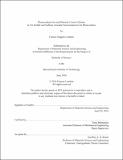Photoconductivity and minority carrier lifetime in tin sulfide and gallium arsenide semiconductors for photovoltaics
Author(s)
Lenahan, Frances Daggett
DownloadFull printable version (9.085Mb)
Other Contributors
Massachusetts Institute of Technology. Department of Materials Science and Engineering.
Advisor
Tonio Buonassisi.
Terms of use
Metadata
Show full item recordAbstract
The growth and maintenance of the modern technological world requires immediate solutions in the field of clean, renewable energy. One prominent solution is the rapid advancement of solar cell technologies due to the wide availability of solar energy and the growing versatility of harnessing it. As efficiencies for these devices creep upwards, it becomes increasingly more important to find the greatest inhibiting factor. Through a solar cell simulator program (SCAPS), improvements in the minority-carrier lifetime of cell materials show not only significant improvements in cell efficiencies, but also an un-masking of improvements by other properties, which are inhibited when the lifetime is too short. This work aims to calculate the mobilitylifetime products ([mu][tau]) of gallium arsenide (GaAs) and annealed and un-annealed tin sulfide (SnS) with respective p-doping carrier concentrations of 1018 cm-3, 1016 cm-3, and 1015 cm-3 through photoconductivity measurements. Films are 1 [mu]m thick and have a four-bar and two-bar contact configuration to model carrier conductivity as a sheet. For calculations, two methods of modeling charge carrier generation are considered; a uniform generation throughout the film and a depth and wavelength-dependent generation. This work found values on the order of 10-1 cm2 V-1, 10-4 cm2 V-1, and 10-5 cm2 V-1, for GaAs, annealed SnS, and un-annealed SnS, respectively, for both methods of calculation. The simplified approach considering a uniform generation yielded lower results than the depth and wavelength dependent calculations by about a factor of two. All values were three to four orders of magnitude higher than those found in the literature. For this reason, it is believed that the majority-carrier is dominating measurements due to an inhibited minority-carrier lifetime.
Description
Thesis: S.B., Massachusetts Institute of Technology, Department of Materials Science and Engineering, 2016. This electronic version was submitted by the student author. The certified thesis is available in the Institute Archives and Special Collections. Cataloged from student-submitted PDF version of thesis. Includes bibliographical references (pages 54-55).
Date issued
2016Department
Massachusetts Institute of Technology. Department of Materials Science and EngineeringPublisher
Massachusetts Institute of Technology
Keywords
Materials Science and Engineering.